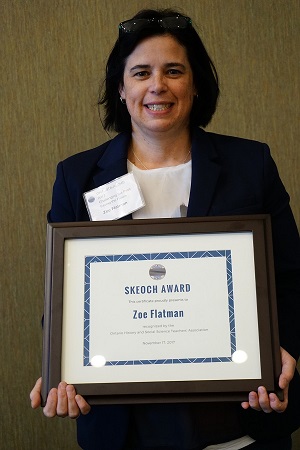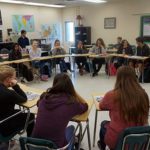
By Risa Gluskin
At the annual OHASSTA conference, held in Ottawa from November 16 to 17, we challenged the past and faced the future – our theme. In 2017, during Canada 150+, we are in that interesting position of simultaneously looking in the mirror and charting a path forward. If you couldn’t join us, here’s an overview.
Greek woman holding a mirror, 470-460 BCE, https://en.wikipedia.org/wiki/Mirror#/media/File:NAMA_Femme_au_miroir.jpg
Our first keynote speaker was Susan Delacourt, political columnist for the Toronto Star. She enlightened us with interesting stories about political figures past and present. She got the ball rolling on what I perceived as the other theme of the conference: fake news, or at least credibility of sources. Susan had some interesting remarks on the need for all sides in political debates to have an agreed upon set of facts.
Thursday evening a group of conference attendees visited the Canadian Museum of History to tour the newly revamped Canadian History Hall. We had a wonderful tour led by Heather Montgomery. We took in the refashioned exhibit, stopping at key points to get some ‘behind the scenes’ pointers. The new exhibit is especially strong in integrating the presence and voice of Indigenous people. In fact, it begins with the Algonquin creation story presented in a beautiful light installment.
Our second keynote speaker was Ian McKay, co-author of The Vimy Trap: Or, How We Learned to Stop Worrying and Love the Great War. He challenged us to look at the evidence about the Battle of Vimy Ridge. In his view, the evidence does not support the view of Vimy that tends to dominate today.
We also heard from Paulette Tremblay, Chief Executive Officer of the Assembly of First Nations. Dr. Tremblay is Turtle Clan of the Mohawk Nation from Six Nations of the Grand River Territory in southern Ontario. She shared her thoughts on the importance of education in reconciliation.
Zoe Flatman, a teacher at Riverdale CI in Toronto, received the Skeoch Award. She shared her appreciation of collaboration with colleagues and networking through conferences such as OHASSTA.
Rapport, as a printed magazine, was available to each conference attendee. For those who couldn’t attend, here’s the link.
After two thought-provoking days I was left questioning my own practices regarding fake news, evidence and credibility. Here are some links to read up on these topics.
We hope you will join us next November in Toronto.
Fake News
https://sheg.stanford.edu/about/updates/2017/new-research-featured-npr-chronicle-higher-ed
Stanford History Education Group’s article on teaching students to be fact checkers
https://sheg.stanford.edu/civic-online-reasoning
SHEG’s Civic Online Reasoning
http://www.cbc.ca/news/canada/toronto/fake-news-students-media-literacy-1.4297256
CRAAP Test
A link to my adapted version of the famous reliability test for websites. I have tried to make it easy for students to score.
The Bechdel test (read on if you don’t know what it is)
https://www.theatlantic.com/entertainment/archive/2015/08/call-it-the-bechdel-wallace-test/402259/


